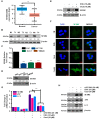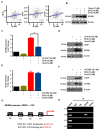Docosahexaenoic Acid Enhances Oxaliplatin-Induced Autophagic Cell Death via the ER Stress/Sesn2 Pathway in Colorectal Cancer
- PMID: 31337142
- PMCID: PMC6678695
- DOI: 10.3390/cancers11070982
Docosahexaenoic Acid Enhances Oxaliplatin-Induced Autophagic Cell Death via the ER Stress/Sesn2 Pathway in Colorectal Cancer
Abstract
Oxaliplatin is an anticancer drug administered to colorectal cancer (CRC) patients in combination with 5-fluorouracil and antibodies (bevacizumab and cetuximab), thereby significantly improving the survival rate of CRC. However, due to various side effects associated with the above treatment strategy, the need for combinatorial therapeutic strategies has emerged. Based on the demand for new combinatorial therapies and the known antitumor effects of the omega-3 polyunsaturated fatty acid, docosahexaenoic acid (DHA), we investigated the Oxaliplatin and DHA combination for its effect. Our results indicated that DHA further enhanced Oxaliplatin-induced cell viability and autophagic cell death, in vitro and in vivo. Oxaliplatin and DHA also increased the expression of Sestrin 2 (SESN2) and endoplasmic reticulum (ER) stress related C/EBP homologous protein (CHOP). Additionally, treatment with Oxaliplatin and DHA enhanced the binding of CHOP to the promotor region of SESN2, increasing SESN2 expression. These results suggested that DHA enhanced Oxaliplatin-induced reduction in cell viability and increase in autophagy via activating SESN2 and increasing ER stress. Thus, SESN2 may be an effective preclinical target for CRC treatment.
Keywords: Oxaliplatin; Sestrin 2; autophagic cell death; colon cancer; docosahexaenoic acid.
Conflict of interest statement
The authors declare that they have no competing interests.
Figures







Similar articles
-
Synergistic antitumor effect of 5-fluorouracil and withaferin-A induces endoplasmic reticulum stress-mediated autophagy and apoptosis in colorectal cancer cells.Am J Cancer Res. 2020 Mar 1;10(3):799-815. eCollection 2020. Am J Cancer Res. 2020. PMID: 32266092 Free PMC article.
-
Endoplasmic reticulum-targeting photosensitizer Hypericin confers chemo-sensitization towards oxaliplatin through inducing pro-death autophagy.Int J Biochem Cell Biol. 2017 Jun;87:54-68. doi: 10.1016/j.biocel.2017.04.001. Epub 2017 Apr 6. Int J Biochem Cell Biol. 2017. PMID: 28392376
-
Luteolin prevents liver from tunicamycin-induced endoplasmic reticulum stress via nuclear factor erythroid 2-related factor 2-dependent sestrin 2 induction.Toxicol Appl Pharmacol. 2020 Jul 15;399:115036. doi: 10.1016/j.taap.2020.115036. Epub 2020 May 11. Toxicol Appl Pharmacol. 2020. PMID: 32407927
-
Transcriptomic Profiling of MDA-MB-231 Cells Exposed to Boswellia Serrata and 3-O-Acetyl-B-Boswellic Acid; ER/UPR Mediated Programmed Cell Death.Cancer Genomics Proteomics. 2017 Nov-Dec;14(6):409-425. doi: 10.21873/cgp.20051. Cancer Genomics Proteomics. 2017. PMID: 29109091 Free PMC article. Review.
-
New oxaliplatin-based combinations in the treatment of colorectal cancer.Colorectal Dis. 2003 Nov;5 Suppl 3:1-9. doi: 10.1046/j.1463-1318.5.s3.2.x. Colorectal Dis. 2003. PMID: 23573555 Review.
Cited by
-
Comparative Study of Autophagy in Oxaliplatin-Sensitive and Resistant SNU-C5 Colon Cancer Cells.Biomol Ther (Seoul). 2022 Sep 1;30(5):447-454. doi: 10.4062/biomolther.2022.028. Epub 2022 May 25. Biomol Ther (Seoul). 2022. PMID: 35611548 Free PMC article.
-
Autophagy-dependent cell cycle arrest in esophageal cancer cells exposed to dihydroartemisinin.Chin Med. 2020 Apr 25;15:37. doi: 10.1186/s13020-020-00318-w. eCollection 2020. Chin Med. 2020. PMID: 32351616 Free PMC article.
-
Salinomycin triggers prostate cancer cell apoptosis by inducing oxidative and endoplasmic reticulum stress via suppressing Nrf2 signaling.Exp Ther Med. 2021 Sep;22(3):946. doi: 10.3892/etm.2021.10378. Epub 2021 Jul 1. Exp Ther Med. 2021. PMID: 34306210 Free PMC article.
-
Dietary Fat and Cancer-Which Is Good, Which Is Bad, and the Body of Evidence.Int J Mol Sci. 2020 Jun 9;21(11):4114. doi: 10.3390/ijms21114114. Int J Mol Sci. 2020. PMID: 32526973 Free PMC article. Review.
-
Molecular Mechanisms Associated with the Inhibitory Role of Long Chain n-3 PUFA in Colorectal Cancer.Integr Cancer Ther. 2024 Jan-Dec;23:15347354241243024. doi: 10.1177/15347354241243024. Integr Cancer Ther. 2024. PMID: 38708673 Free PMC article. Review.
References
-
- Bendell J.C., Bekaii-Saab T.S., Cohn A.L., Hurwitz H.I., Kozloff M., Tezcan H., Roach N., Mun Y., Fish S., Flick E.D., et al. Treatment patterns and clinical outcomes in patients with metastatic colorectal cancer initially treated with FOLFOX-bevacizumab or FOLFIRI-bevacizumab: Results from ARIES, a bevacizumab observational cohort study. Oncologist. 2012;17:1486–1495. doi: 10.1634/theoncologist.2012-0190. - DOI - PMC - PubMed
LinkOut - more resources
Full Text Sources
Research Materials

